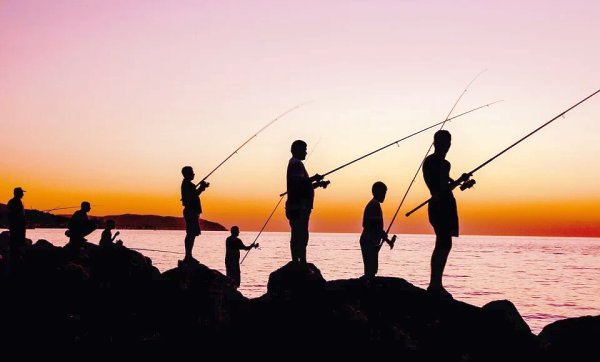
When you are going fishing, whether nearby your home or on a long distance trip, there are many fishing safety rules that you need to keep in mind. These rules can help prevent injury to yourself and others while shore and boat fishing.
There are several different areas of fishing safety that you should be aware of. These include the following:
Equipment Safety
Pier Fishing Safety
Offshore Fishing Safety
Shore Fishing and Noodling Safety
Ice Fishing Safety
Equipment Safety
Before you go fishing, you need to make certain that all of your equipment is in safe working order. This should be done before you even consider going out to any waterfront. You need to check several things while looking over your various pieces of equipment.
First, you need to check your fishing rod and reel. Both of these pieces should be in top condition, with the rod having no cracks or breaks. If your rod separates, you need to make certain that it is very secure when it is built together. The reel itself should operate smoothly, with the line coiling without tangles. If the line is tangling quite a bit within the reel, you will need to unbind the line and replace it with new. If this behavior continues, you should consider a new reel.
The type of line that you use should be a consideration as well. Dependent on the conditions you are going to be fishing in, you will want to use different line. With rocky bottoms, where your line is going to get caught easier, you will want to use a lower line rating. If you are fishing for larger fish, the test on the line should be increased to match what you are planning on catching.
The final fishing safety check that you should make is on your tackle, sinkers and lures. If any of these are rusted, you should replace them with new ones, as rusted equipment can change a mild injury into tetanis or a worse illness.
Pier Fishing Safety
One type of fishing that many people enjoy is pier fishing. When you go fishing off of a pier, there are several fishing safety rules that you should keep in mind.
First, you should only place your feet into the water if you know that there are not vicious fish, such as Muskie, in the water. Muskie, as well as other types of vicious fish, are renown for biting off the toes of unsuspecting fishers off of piers. For this reason, you should avoid doing this.
In addition to this, you should never run on the piers, especially if you are carrying any sharp equipment. The most important thing to keep in mind when pier fishing is to use your common sense. Falling from the pier, especially taller ones, can be life threatening. Leaning over the pier edge, as well as being careless, can put yourself and others in danger.
Offshore Fishing Safety
When you go on a boat for a session of offshore fishing, you need to be extra careful. Out of all of the forms of fishing, this is the most dangerous.
You need to be aware of the weather and potential weather changes at all times. In addition to this, you need to make certain that you are always wearing a life preserver. While these may be uncomfortable, or ugly to wear, they can make the difference between life and death.
You should always make certain that you know you do not hit anyone with your hook when you are casting. This is the most dangerous aspect of offshore fishing, as you are most likely fishing in close quarters, which requires a higher level of skill when you are casting. Hooking yourself or a companion is a real likely hood in this style of fishing, unless you are extremely careful.
Shore Fishing and Noodling
Shore fishing is the style of fishing in which most people participate. During fishing seasons, hundreds of people gather around oceans and rivers and ponds to take their hand at trying to catch the largest fish possible. Lures are constantly flying through the air, and lines get tangled more often than not.
When you are shore fishing, you need to make certain you are aware of all of the people around you, and that they are aware of you. Taking children to crowded beaches for fishing can be extremely dangerous, as they can get hooked while running and playing.
Injuries sustained in this manner can be severe. As long as you are careful, and you do not run or dart across the path of someone casting, shore fishing can be the safest of all types of fishing.
Noodling
There is one form of shore fishing, however, that is extremely dangerous. This is called “Noodling”. Noodling, or another term for “Idiot,” is the practice of wading out to waist or chest level and bending down to search holes, logs and other hiding holes for catfish.
Then you wiggle your fingers. If there is a catfish – or another type of creature in residence – they will attack your bare hand. Then the fight begins, and the Noodler needs to bring the fish to shore. Many lose their lives yearly to this extreme sport, and it should be avoided, as it is not safe.
Ice Fishing Safety
When you are going ice fishing, there are a lot of safety rules that you need to follow at all times. Unlike the other forms of standard fishing, ice fishing presents a lot of health risks.
First, you should never go ice fishing without a well built shack. The shacks provide you shelter while you are ice fishing. Without this shelter, you will be susceptible to hypothermia and other health related problems.
The second thing you need to keep in mind at all times is the condition of the ice and the weather predictions. Falling through the ice while ice fishing, especially alone, is a death sentence. Being trapped on the open ice during a blizzard is also extremely dangerous, even with the shelter of an ice shack available.
When you are stocking your ice shack, you need to make certain that you have enough wood for the wood stove, or heating device within the shack. This device should also be cared for and watched over at all times, so the ice beneath the shack remains stable or that the shack does not burn.
If you keep these fishing safety tips and rules in mind, you should be able to have an enjoyable time fishing without high risk of injury to yourself or others, no matter which form of fishing you choose to participate in.


